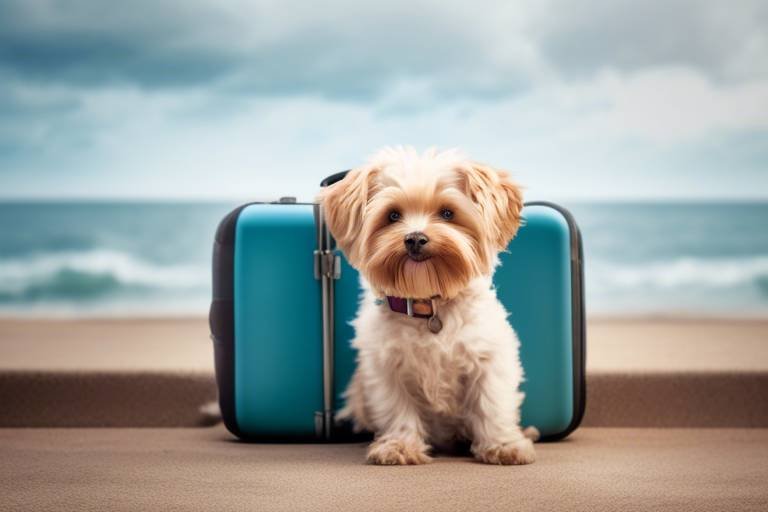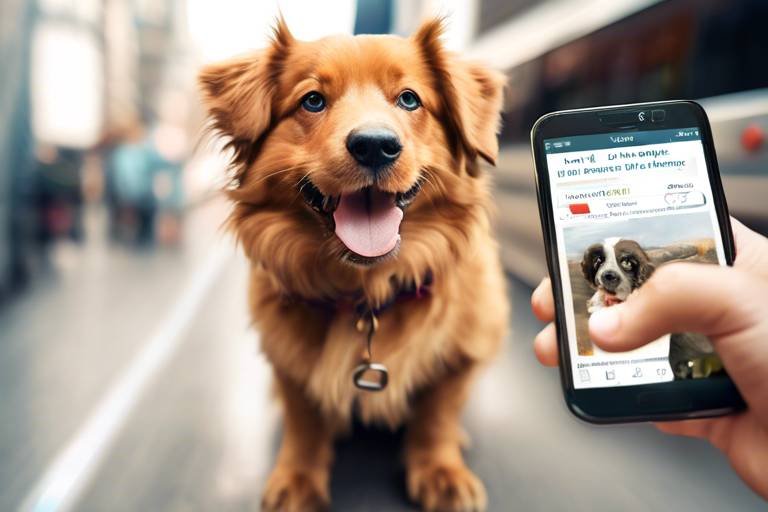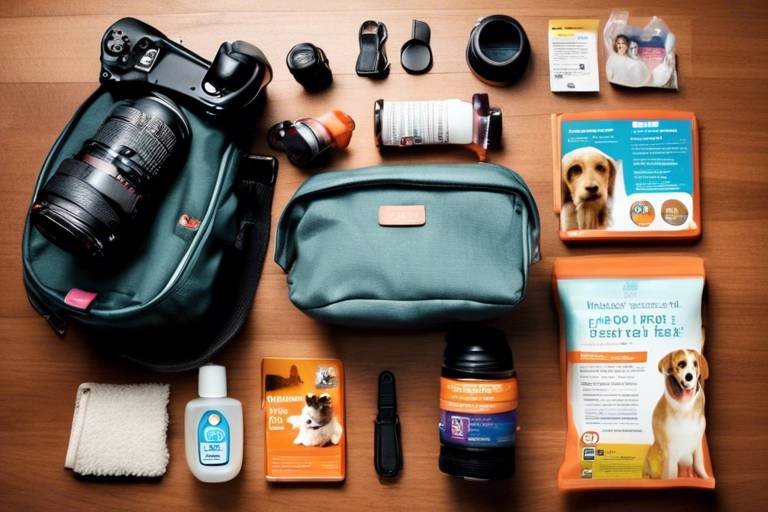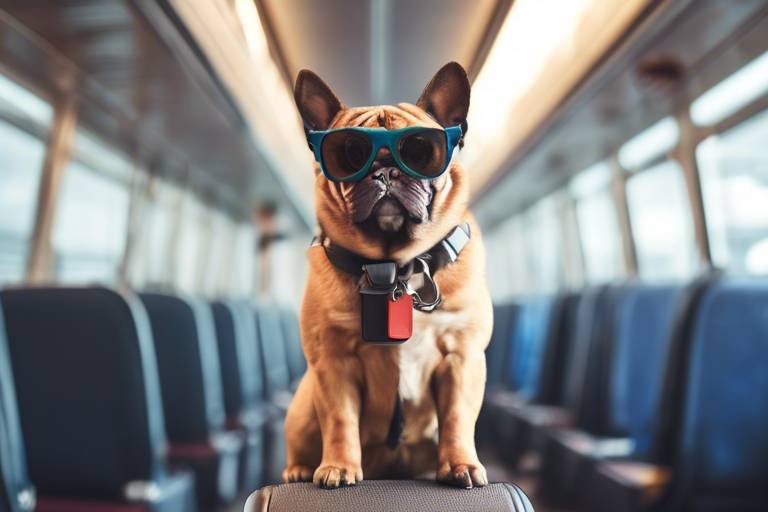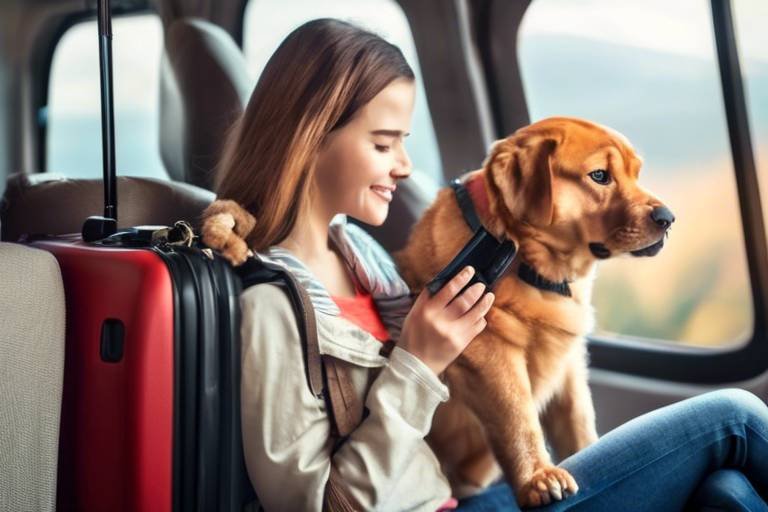How to Choose the Right Travel Destination for Your Pet
Traveling with your furry friend can be one of the most rewarding experiences, but it requires careful planning to ensure both you and your pet have a fantastic time. After all, our pets are part of the family, and they deserve a vacation just as much as we do! But how do you go about choosing the perfect travel destination for your pet? The key is to consider several essential factors that will help you create a trip that is not only enjoyable but also safe and comfortable for your four-legged companion.
First and foremost, think about your pet's unique needs. Every pet has their own personality, health requirements, and preferences. For example, a high-energy dog may thrive in a location with plenty of open spaces and activities, while a more timid pet might prefer a quieter, more serene environment. Take the time to assess your pet's temperament and health status before making any decisions. This will help you choose a destination that caters to their specific requirements, ensuring their comfort and happiness throughout your travels.
Next, consider pet-friendly accommodations. Finding a place to stay that welcomes pets is crucial for a successful trip. Not all hotels or vacation rentals are created equal when it comes to pet policies. Some may charge hefty fees or have strict rules regarding pet sizes and breeds. Therefore, it's essential to research various options, including hotels, vacation rentals, and campsites, to find accommodations that will be both welcoming and comfortable for your pet. Look for amenities like pet beds, food bowls, and even dog parks nearby!
As you plan your getaway, don't forget to check for travel restrictions and regulations. Different destinations have varying rules regarding pet travel, which can sometimes be a headache if you're not prepared. Familiarize yourself with local regulations, vaccination requirements, and any breed-specific restrictions that might apply to your pet. This way, you can avoid any unpleasant surprises at the border or upon arrival.
The climate of your chosen destination is another critical factor. Weather can significantly impact your pet's comfort level. For instance, certain breeds are more susceptible to heat or cold, so it's essential to choose a location with a climate that suits your pet's needs. If you have a short-haired dog, a trip to a tropical paradise might be too much to handle during the summer months. Instead, consider a cooler destination where your pet can enjoy outdoor activities without the risk of overheating or discomfort.
When traveling, it's also a great idea to research available activities for pets. Whether it's dog parks, pet-friendly beaches, or hiking trails, knowing what your destination offers can enhance your travel experience. Imagine your pup splashing around in the ocean or exploring a beautiful nature trail with you! The more activities you can find that cater to your pet, the more exciting your trip will be for both of you.
Transportation is another key element to consider. Evaluate your transportation options, whether you're flying, taking a train, or hitting the road. Each mode of transport comes with its own set of challenges and requirements for traveling with pets. For instance, flying with a pet may require special carriers and advance bookings, while road trips might necessitate frequent stops for bathroom breaks and exercise. Planning ahead will ensure a smooth journey for your beloved pet.
Access to local veterinary services is essential when traveling with pets. It's always a good idea to identify nearby veterinary clinics or emergency services in case of any health concerns during your trip. Knowing where to go in case of an emergency can provide peace of mind, allowing you to relax and enjoy your vacation without worry.
Traveling can also provide fantastic socialization opportunities for your pet. Look for pet-friendly events, meetups, or local parks where your furry friend can interact with other animals and people. This can be a fun way for your pet to make new friends and for you to meet fellow pet lovers!
Lastly, don't forget about budgeting for pet travel. Traveling with pets can incur additional expenses, so it's crucial to plan accordingly. Consider costs for accommodations, transportation, food, and activities to ensure a financially stress-free experience while enjoying your trip together. After all, the last thing you want is to worry about money while trying to create beautiful memories with your pet.
- Can I take my pet on a plane? Yes, but you need to check the airline's pet policy and ensure you have an appropriate carrier.
- What should I pack for my pet? Bring food, water, bowls, leash, waste bags, toys, and any medications your pet may need.
- Are there any destinations that are particularly pet-friendly? Many national parks, beach towns, and cities like Portland, Oregon, and Asheville, North Carolina are known for being pet-friendly.
- How can I keep my pet safe while traveling? Always use a secure harness or carrier, keep an eye on them in new environments, and ensure they are up-to-date on vaccinations.

Understanding Your Pet's Needs
When it comes to traveling with your furry friend, understanding your pet's unique needs is paramount. Just like humans, pets have their own personalities, health conditions, and preferences that can significantly impact their travel experience. For instance, a high-energy dog may thrive in an active environment filled with hiking trails and dog parks, while a more laid-back cat might prefer a quiet beachside retreat. So, how do you figure this out?
First, consider your pet's health status. Is your pet elderly or have any health issues? If so, you might want to choose a destination that is not too far from veterinary services. It’s also important to check if your pet has any allergies or sensitivities. For example, some pets may be allergic to certain types of grass or pollen, which could be a concern in certain locations.
Next, think about your pet's temperament. Does your pet enjoy meeting new people and other animals, or are they more of a lone wolf? If your pet tends to be shy or anxious, a bustling city might not be the best choice. On the other hand, if your pet is social and loves to play, a dog-friendly park or pet event could be a perfect fit. Understanding these traits will help you select a destination that suits their personality.
Furthermore, consider your pet's preferences. Dogs, for instance, often enjoy places where they can run freely, while cats might prefer cozy spots where they can observe their surroundings. You can even create a simple table to help visualize what your pet enjoys:
| Pet Type | Preferred Activities | Best Destinations |
|---|---|---|
| Dog | Running, Fetch, Swimming | Dog Parks, Beaches |
| Cat | Climbing, Exploring | Quiet Cabins, Gardens |
| Rabbit | Hopping, Digging | Open Fields, Farms |
Lastly, it’s essential to factor in your pet's routine. Pets thrive on routine, and a sudden change in their environment can be stressful. If your pet is used to a specific feeding schedule or sleep pattern, try to maintain that as much as possible during your travels. This will help keep their stress levels down and make for a more enjoyable trip.
In summary, understanding your pet's needs involves a mix of assessing their health, temperament, preferences, and routine. By taking the time to evaluate these factors, you can ensure a travel experience that is not only enjoyable but also safe and comfortable for your beloved companion.
- What should I do if my pet gets anxious during travel? Consider bringing their favorite toys or blankets to provide comfort.
- How can I find pet-friendly accommodations? Websites like BringFido and Airbnb often list pet-friendly options.
- Are there any specific regulations for traveling with pets? Yes, regulations can vary by country and even state, so it’s best to check ahead of time.

Pet-Friendly Accommodations
When it comes to traveling with your furry friend, finding the right is crucial for a stress-free experience. Imagine arriving at your destination only to find out that your beloved pet isn't welcome – it's a nightmare scenario, right? To avoid such a situation, start your search early. Many hotels, vacation rentals, and campsites now cater specifically to pet owners, offering amenities that make your stay comfortable for both you and your pet.
While searching for accommodations, consider what facilities are available. Some places offer pet beds, bowls, and even treats upon arrival, while others have specific pet areas or trails for walks. It's essential to read reviews from other pet owners to gauge how truly pet-friendly a place is. Websites and apps dedicated to pet-friendly travel can be a goldmine for finding the best spots. Look for accommodations that allow pets without hidden fees, as these can quickly add up and strain your travel budget.
Don’t forget to check if there are any restrictions on the size or breed of pets allowed. Some accommodations may only accept small dogs or specific breeds, which can be a dealbreaker for many pet owners. Additionally, inquire about the pet policies – are there designated areas for pets? Are they allowed on furniture? Understanding these details will help you avoid any unpleasant surprises during your stay.
Here's a quick comparison of different types of pet-friendly accommodations:
| Type of Accommodation | Pros | Cons |
|---|---|---|
| Hotels | Often have pet amenities; convenient locations | May charge extra fees; limited space |
| Vacation Rentals | More space; home-like environment | Not all are pet-friendly; cleaning fees may apply |
| Campsites | Great for outdoor activities; usually very pet-friendly | Less comfort; limited amenities |
Lastly, don’t underestimate the importance of location. Choose accommodations that are near parks, beaches, or trails where you can take your pet for walks and playtime. The more pet-friendly options available nearby, the better your experience will be. After all, a happy pet makes for a happy trip!
- What should I look for in pet-friendly accommodations? Look for amenities such as pet beds, bowls, and nearby parks, and check for any size or breed restrictions.
- Are there additional fees for pets? Many places do charge additional fees, so it’s essential to ask about this when booking.
- Can I leave my pet alone in the room? Policies vary by accommodation, so check their specific rules regarding leaving pets unattended.

Travel Restrictions and Regulations
When it comes to traveling with your furry friend, understanding is paramount. Different destinations have unique rules that can affect your plans, so doing your homework ahead of time can save you from unexpected surprises. Imagine arriving at a beautiful beach destination only to find out that your pet isn't allowed on the premises! To avoid such scenarios, start by researching the specific pet travel laws in your chosen location.
Many places have regulations regarding the types of pets allowed, their size, and even breed-specific restrictions. For instance, some states have laws that prohibit certain breeds, while others may have restrictions based on the size of your pet. Additionally, local ordinances may dictate leash laws, pet behavior expectations, and even designated pet areas. This is where a little pre-trip research can go a long way. It’s like checking the weather forecast before a picnic; you want to be prepared!
Another critical aspect to consider is vaccination requirements. Some destinations may require specific vaccinations or health certificates to ensure your pet is healthy and safe to travel. For example, many countries have strict regulations regarding rabies vaccinations, and failure to comply could mean being turned away at the border or, worse, having to quarantine your pet. Always check the latest guidelines from local authorities or travel websites to ensure you have the right documentation. Here’s a quick reference table for common requirements:
| Destination | Required Vaccinations | Health Certificate Needed |
|---|---|---|
| California, USA | Rabies | Yes |
| Hawaii, USA | Rabies, Leptospirosis | Yes |
| Australia | Rabies, Canine Parvovirus | Yes |
| Canada | Rabies | Yes |
Additionally, it’s important to consider transportation regulations. If you're flying, each airline has its own set of rules regarding pet travel. Some airlines allow pets in the cabin, while others may require them to be transported in the cargo hold. Always check the specific airline's pet policy before booking your flight to avoid any last-minute changes. If you're traveling by train or bus, similar regulations apply, and it’s essential to confirm their pet policies as well.
Lastly, don’t forget to look into any potential quarantine laws that may apply. Some countries have strict quarantine laws that can affect your travel plans significantly. If you’re traveling internationally, it’s crucial to ensure that your pet meets all the entry requirements to avoid long delays or, worse, being sent back home. Think of it as preparing for a big exam; you wouldn’t want to walk in unprepared!
In summary, taking the time to understand the travel restrictions and regulations for your destination can make all the difference in ensuring a smooth and enjoyable trip for both you and your pet. So, before you pack your bags, gather your pet’s essentials, and hit the road, make sure you’re fully informed about the rules that will govern your adventure.
- What should I do if my pet is denied entry at my destination? It's best to contact local authorities or the embassy for guidance on how to proceed.
- Are there any pets that are not allowed in certain countries? Yes, some countries have restrictions on specific breeds or species of pets.
- How can I ensure my pet is healthy enough to travel? Schedule a vet appointment before your trip to get a health check and necessary vaccinations.

Climate Considerations
When planning a trip with your furry friend, one of the most critical factors to consider is the climate of your chosen destination. Just like us, pets can be sensitive to extreme temperatures, whether it’s the sweltering heat of summer or the biting cold of winter. Imagine taking your beloved dog to a tropical paradise only to find that the heat is too intense for their delicate paws. It’s essential to match your pet's breed and health to the climate of the location you’re considering.
For instance, if you have a short-haired breed, such as a Chihuahua, they may struggle in colder climates. Conversely, a thick-coated breed like a Siberian Husky might find a warm beach vacation uncomfortable. It's crucial to assess your pet's tolerance levels and choose a climate that keeps them happy and healthy. Here’s a quick guide to help you evaluate:
| Breed Type | Ideal Climate | Considerations |
|---|---|---|
| Short-Haired Breeds | Temperate to Warm | May need cooling products and shaded areas. |
| Long-Haired Breeds | Cool to Temperate | Watch for overheating in hot climates. |
| Senior Pets | Moderate | Be cautious of extreme temperatures; consider indoor activities. |
| Puppies/Kittens | Warm and Comfortable | Ensure they have a safe space to cool down. |
Moreover, the season you choose to travel can greatly impact your pet’s experience. Summer vacations may be filled with outdoor adventures, but they also come with the risk of heatstroke. Always carry plenty of water and take frequent breaks in shaded areas. On the other hand, winter trips can be magical, but make sure your pet is equipped with a cozy sweater or jacket to keep them warm during chilly outings.
Don’t forget about allergies and air quality as well. Certain regions may have pollen counts that could trigger allergic reactions in pets, just like they do in humans. Before you go, check the local weather forecasts and any air quality alerts to ensure your pet won’t be adversely affected.
Ultimately, the key to a successful trip lies in doing your homework. Research the climate of your destination, consider your pet’s unique needs, and plan accordingly. After all, a happy pet means a happy vacation!
- What should I do if my pet is not used to hot weather? - Gradually acclimate them to warmer temperatures by taking short walks and increasing the duration over time.
- How can I keep my pet cool during summer travels? - Provide plenty of water, avoid walking on hot pavement, and consider using cooling vests or mats.
- Are there any specific breeds that are more sensitive to cold weather? - Yes, breeds like Greyhounds and Chihuahuas are more susceptible to cold temperatures and should be kept warm.
- What should I pack for my pet in different climates? - Pack appropriate clothing, hydration supplies, and any necessary medications, regardless of the climate.

Available Activities for Pets
When it comes to traveling with your furry friend, one of the most exciting aspects is discovering activities that cater to pets. After all, what’s a vacation without some fun for your beloved companion? Imagine exploring a new place together, where your pet can run freely, sniff new scents, and meet other furry friends. But how do you find these pet-friendly activities? Well, let’s dive into the options!
First, you’ll want to research the area you’re visiting. Many destinations offer a plethora of pet-friendly attractions that can turn an ordinary trip into an extraordinary one. For instance, consider looking for:
- Dog Parks: These are fantastic spots where your dog can socialize and play off-leash. They often feature agility courses, water fountains, and shaded areas for those hot days.
- Pet-Friendly Beaches: Nothing beats a day at the beach! Many coastal towns have designated areas where dogs are welcome to splash in the waves and dig in the sand.
- Hiking Trails: If your pet loves the great outdoors, check for nearby trails that allow pets. Just make sure they’re suitable for your pet’s fitness level!
- Cafes and Restaurants: Some eateries welcome pets on their patios, allowing you to enjoy a meal while your furry friend relaxes by your side.
Additionally, don’t forget about local pet events! Many communities host pet parades, festivals, or meetups where your pet can mingle with others. These events not only provide socialization opportunities but also allow you to meet fellow pet owners, share tips, and discover hidden gems in the area.
Now, let’s not overlook the importance of checking for pet-friendly accommodations that are close to these activities. The closer you are to the action, the easier it will be for you and your pet to enjoy everything without the hassle of long drives. Imagine waking up, grabbing a quick breakfast, and heading straight to a nearby park or beach!
Lastly, always remember to pack your pet’s favorite toys, water, and snacks to keep them happy and comfortable during your adventures. With a little planning and research, you can ensure that your pet has a fantastic time exploring new surroundings, making memories that you'll cherish forever.
Q: How can I find pet-friendly activities in a new city?
A: Websites like BringFido and local tourism boards often list pet-friendly attractions, events, and accommodations in your destination. Social media groups for pet owners can also be a great resource!
Q: Are there any restrictions on where pets can go?
A: Yes, some places may have restrictions, especially indoor venues or certain public spaces. Always check the rules before heading out to avoid any surprises.
Q: What should I do if my pet is not social with other animals?
A: If your pet is shy or anxious around other animals, consider quieter activities like hiking or exploring pet-friendly shops where they can still enjoy the outing without overwhelming interactions.
Q: Can I take my pet to restaurants?
A: Many restaurants with outdoor seating allow pets, but it’s always best to call ahead and confirm their pet policy.

Transportation Options
When it comes to traveling with your furry friend, can make or break your adventure. Imagine this: you're all packed and ready to hit the road, but then you realize that your chosen mode of transport isn't pet-friendly. The thought alone can send shivers down your spine, right? So, let's dive into the various ways you can travel with your pet, ensuring a smooth and enjoyable journey for both of you.
First off, consider how you plan to get to your destination. Are you thinking of driving, flying, or taking a train? Each option has its pros and cons, and understanding them can help you make the best choice for your pet's comfort and safety. For instance, if you're going on a road trip, your pet can enjoy the freedom to stretch out, take breaks, and explore new sights along the way. Just remember to secure them safely in the vehicle, either with a pet seatbelt or a travel crate, to keep them safe during sudden stops or turns.
On the other hand, flying might be necessary for longer distances. Many airlines now offer pet-friendly policies, allowing pets to travel in the cabin with you or in the cargo hold. However, it's crucial to check the airline's specific regulations, as they can vary significantly. For example, some airlines only allow pets under a certain weight to travel in the cabin, while others may have restrictions based on breed or size. Make sure you book your flight in advance and confirm your pet's reservation, as spots can fill up quickly.
Trains can also be a fantastic option for pet travel. Many train services are becoming increasingly accommodating to pets, allowing them to travel with you in designated areas. This option often provides more space for your pet to move around compared to airplanes. Just like with airlines, check the specific rules for the train service you plan to use, including any fees that may apply.
Here's a quick comparison of transportation options:
| Transportation Mode | Pros | Cons |
|---|---|---|
| Car |
|
|
| Airplane |
|
|
| Train |
|
|
Whichever option you choose, always remember to pack essentials for your pet, including food, water, a leash, and any comfort items they may need. A little preparation can go a long way in ensuring that your pet feels secure and relaxed during the journey. And don't forget to take regular breaks to stretch those legs and give your pet a chance to relieve themselves!
Ultimately, the right transportation for your pet will depend on your specific travel plans and your pet's personality. Some pets thrive on the excitement of a car ride, while others may prefer the calmness of a train. By considering your options and planning ahead, you can create a travel experience that is enjoyable for both you and your beloved pet.
Q: Can I take my pet on a plane?
A: Yes, many airlines allow pets to travel in the cabin or cargo hold, but you'll need to check their specific policies and make a reservation for your pet.
Q: What should I pack for my pet when traveling?
A: Bring food, water, a leash, waste bags, and any comfort items like a favorite blanket or toy to help your pet feel at ease.
Q: How can I keep my pet calm during travel?
A: Familiarize your pet with their travel crate or carrier before the trip, and consider using calming aids if your pet is particularly anxious.

Local Veterinary Services
When embarking on a journey with your furry friend, one of the most crucial aspects to consider is access to . Just like you would check for nearby hospitals when traveling with children, ensuring that there are quality veterinary clinics nearby can provide peace of mind during your trip. Imagine being in a new place, enjoying the sun, and suddenly your pet has an upset stomach. The last thing you want is to scramble for help in an unfamiliar area!
Before you set off, take some time to research the veterinary clinics available at your destination. Look for establishments that not only offer general care but also have emergency services. You can start by searching online for “veterinary services near me” once you arrive, but having a list prepared beforehand can save you precious time in case of an emergency.
Here are a few things to consider when looking for local veterinary services:
- Reputation: Check online reviews and ratings. Websites like Yelp or Google Reviews can provide insights into the experiences of other pet owners.
- Services Offered: Ensure the clinic provides a full range of services, including emergency care, vaccinations, and routine check-ups.
- Location: Choose a clinic that is conveniently located, ideally within a short drive from your accommodation.
- Availability: Confirm whether the clinic has extended hours or is open on weekends. This can be crucial if your pet needs immediate attention.
To help you in your search, here’s a simple table comparing a few key factors of potential veterinary clinics:
| Clinic Name | Distance (miles) | Emergency Services | Hours of Operation |
|---|---|---|---|
| Paws & Claws Veterinary Clinic | 2.5 | Yes | Mon-Sat: 8 AM - 8 PM |
| Happy Tails Animal Hospital | 1.8 | No | Mon-Fri: 9 AM - 5 PM |
| Furry Friends Vet Center | 3.0 | Yes | 24/7 |
Additionally, it’s wise to have your pet’s medical history handy. This includes vaccination records, any medications they are currently taking, and details about any pre-existing conditions. Having this information readily available can help the vet provide the best possible care in case of an emergency.
In conclusion, while traveling with your pet can be an adventure filled with joy and bonding moments, ensuring access to reliable local veterinary services is a fundamental step in planning your trip. By being proactive and doing your research, you can focus on making wonderful memories with your furry companion, rather than worrying about what to do if something goes wrong.
Q: What should I do if my pet gets sick while traveling?
A: First, remain calm. Refer to your list of local veterinary services and contact the nearest clinic. If your pet has a known condition, make sure you have their medical records and medications on hand to share with the vet.
Q: Do I need to bring my pet's medical records with me?
A: Yes, it’s advisable to bring your pet’s medical history, including vaccination records and any medications. This information can be crucial for any veterinary care your pet might need while traveling.
Q: How can I find a vet quickly in an unfamiliar area?
A: Use your smartphone to search for “veterinary services near me” or check local directories. It’s also helpful to have a few clinics noted down before you travel.

Socialization Opportunities
Traveling with your pet isn't just about exploring new places; it's also a fantastic opportunity for socialization. Just like humans, pets thrive on interaction with others. When you choose a travel destination that offers various socialization opportunities, you're not only enriching your pet's life but also enhancing your own travel experience. Imagine your furry friend playing in a vibrant park, surrounded by other dogs, or meeting new people who adore pets just as much as you do. It's a win-win situation!
Before you set off on your adventure, it's essential to research local events and activities that allow your pet to mingle. Many cities host pet-friendly events, such as dog shows, festivals, and even charity walks. These occasions are perfect for your pet to meet other animals and their owners, fostering a sense of community and belonging. Plus, you might make some new friends along the way!
Consider visiting local parks that are known for being pet-friendly. Some parks even have designated areas where dogs can run off-leash, providing them with a safe space to interact freely. Here’s a quick table to help you understand the types of socialization opportunities you can find:
| Type of Socialization Opportunity | Description |
|---|---|
| Dog Parks | Open spaces where dogs can play off-leash and socialize with other dogs. |
| Pet-Friendly Events | Local gatherings that welcome pets, such as festivals, parades, or meetups. |
| Pet Cafes | Cafes where pets are allowed, providing a relaxed environment for socialization. |
| Training Classes | Workshops or classes that focus on training and socializing pets in a group setting. |
When planning your itinerary, make sure to include time for these socialization activities. Not only will your pet enjoy the interaction, but you'll also appreciate the joy of watching them thrive in new environments. Remember, the more your pet interacts with others, the more confident and well-adjusted they will become. It’s like a mini-vacation for their social skills!
In conclusion, don't underestimate the power of socialization during your travels. By seeking out pet-friendly events and spaces, you're giving your companion the chance to connect with others, which is vital for their happiness and well-being. So pack your bags, grab the leash, and get ready for an adventure that both you and your pet will cherish!
Q: What are some good ways to socialize my pet while traveling?
A: Look for local dog parks, pet-friendly events, and cafes. Engaging in group training classes can also be beneficial.
Q: How can I find pet-friendly events in my travel destination?
A: Check local community boards, social media groups, or websites dedicated to pet owners for upcoming events.
Q: Is it safe to let my pet off-leash in public areas?
A: Only let your pet off-leash in designated areas where it is permitted, and ensure your pet has good recall skills.
Q: What should I do if my pet is shy or anxious around other animals?
A: Gradually introduce your pet to new environments and other animals. Start with less crowded places and observe their comfort level.

Budgeting for Pet Travel
Traveling with your furry friend can be one of the most rewarding experiences, but it also comes with its own set of financial considerations. When planning your trip, it’s essential to have a clear budget that accounts for all possible expenses. Think of it as creating a roadmap for your adventure—without it, you might find yourself lost in a sea of unexpected costs!
First and foremost, you’ll want to consider the cost of accommodations. Pet-friendly hotels and vacation rentals often charge additional fees for pets. These fees can vary widely, so it’s wise to research and compare different options. For instance, some places might have a flat fee, while others may charge per night. Here’s a quick comparison table to give you an idea:
| Accommodation Type | Average Cost per Night | Pet Fee |
|---|---|---|
| Pet-Friendly Hotel | $100 - $200 | $25 - $50 |
| Vacation Rental | $150 - $300 | $50 - $100 |
| Campsite | $30 - $80 | $10 - $20 |
Next, don’t forget to factor in transportation costs. Whether you're driving or flying, there are expenses associated with getting your pet to your destination. If you’re flying, check with airlines about their pet policies and fees, as these can add up quickly. On the other hand, if you’re hitting the road, consider the cost of gas, food, and any necessary stops along the way.
Another crucial aspect of budgeting for pet travel is food and supplies. Make sure to pack enough food for the trip, along with any treats or medications your pet may need. It’s also a good idea to set aside some cash for unexpected expenses, such as pet-friendly attractions or last-minute supplies. Here’s a quick list of items you might need to budget for:
- Pet food and treats
- Leash, collar, and tags
- Travel crate or carrier
- Water and food bowls
- Pet first-aid kit
Lastly, consider setting aside a portion of your budget for emergency veterinary care. Accidents can happen, and it’s always better to be prepared. Research local veterinary services at your destination and keep their contact information handy. This way, you can enjoy your trip without constantly worrying about what might happen if your pet gets sick or injured.
In conclusion, budgeting for pet travel doesn’t have to be overwhelming. By planning ahead and considering all potential expenses, you can ensure a smooth and enjoyable journey for both you and your pet. Think of it as investing in memories that will last a lifetime—because every adventure with your furry companion is worth every penny!
1. How can I save money while traveling with my pet?
You can save money by booking accommodations that offer pet-friendly deals, traveling during off-peak seasons, and preparing your own pet food instead of buying it on the road.
2. Are there any hidden fees I should be aware of?
Yes, always check for additional pet fees at hotels or rentals, and be aware of potential charges for pet-friendly activities or transportation.
3. What should I do if my pet gets sick while traveling?
Research local veterinary services in advance and keep their contact information accessible. Having a pet first-aid kit can also be helpful for minor issues.
4. Can I take my pet to restaurants or attractions?
Many places have pet-friendly policies, but it’s best to check in advance. Look for outdoor dining options or specific attractions that welcome pets.
Frequently Asked Questions
- What should I consider when choosing a travel destination for my pet?
When selecting a travel destination for your furry friend, consider factors like their health, temperament, and preferences. It's essential to find a place that accommodates their unique needs, ensuring they feel comfortable and happy throughout the trip.
- Are there specific accommodations that are pet-friendly?
Absolutely! Many hotels, vacation rentals, and campsites welcome pets. It's important to research and book places that not only allow pets but also provide amenities to make your stay enjoyable for both you and your pet.
- What travel restrictions should I be aware of?
Different destinations have varying regulations regarding pet travel, including vaccination requirements and breed-specific restrictions. Always familiarize yourself with local laws to avoid any complications during your trip.
- How does climate affect my pet's travel experience?
The weather can significantly impact your pet's comfort. Choose a destination with a climate that suits your pet's breed, ensuring they can enjoy outdoor activities without the risk of overheating or discomfort.
- What activities can I do with my pet at the destination?
Research activities that cater to pets, such as dog parks, pet-friendly beaches, or hiking trails. Knowing what your destination offers can enhance your travel experience and keep your furry companion entertained.
- What transportation options are available for traveling with pets?
Consider various pet-friendly transportation options, including airlines, trains, or road trips. Make sure to plan ahead to ensure a smooth journey for your pet, taking into account their comfort and safety.
- How can I find veterinary services while traveling?
Before you travel, identify nearby veterinary clinics or emergency services at your destination. Having this information handy can provide peace of mind in case of any health concerns during your trip.
- Are there socialization opportunities for my pet while traveling?
Yes! Traveling can be a great way for your pet to socialize. Look for pet-friendly events, meetups, or local parks where your pet can interact with other animals and people, making their travel experience even more enjoyable.
- How do I budget for traveling with my pet?
Traveling with pets can incur additional expenses, so it's crucial to budget for accommodations, transportation, food, and activities. Planning ahead can help ensure a financially stress-free experience while enjoying your trip together.





